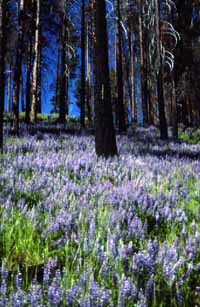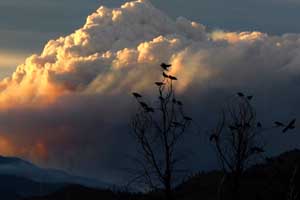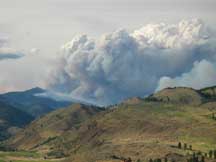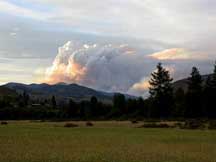Farewell Fire
The Farewell fire burned in the Okanogan National Forest in north central Washington State in 2003. It burned within the Pasayten Wilderness in mid to high elevation forests. These forests are primarily composed of lodgepole pine, subalpine fir and Douglas-fir. Fire is a normal event in these forests which often burn intensely every 50 to 200 years. The fire burned through areas of mature timber and along the edges of areas that burned in the last decade (30-mile Fire and Thunder Mountain Fire). The Farewell Fire burned through the lower part of the appropriately named Fire Creek valley and crossed the upper Chewuch River, then gradually moved both north and east before being extinguished. Much of the area that burned was burned in 1929 and 1930. The fire reached a natural barrier of high mountain ridges and subalpine terrain on the west and was not able to move much further in those directions.
On August 12, 2003 the fire perimeter was 81,343 acres. On that date, the fire was 85% contained and full containment was expected by the end of the day. Fire suppression costs have now exceeded 35 million dollars. According to Judy Beck, a fire behavior specialist with the British Colombia Ministry of Forests, "The amount of money that the United States has spent on the Farewell fire alone is the same amount of money British Colombia has had to fight all of its fires this year."
The following is a press release from July 23, 2003:
FOR IMMEDIATE RELEASE July 23, 2003
Mitch Friedman, Northwest Ecosystem Alliance
Peter Morrison, Pacific Biodiversity Institute
Tim Coleman, Kettle Range Conservation Group
Conservationists Laud Forest Service Response to Farewell Fire
Winthrop, WA Forest conservation leaders in Washington State today announced their support of the approach the US Forest Service has taken in responding to the Farewell Fire in northcentral Washington. Under hot and dry conditions, the fire has grown from a perimeter of 7,000 to 60,000 acres over the past eleven days.
"This is growing to be a rather big fire," said Mitch Friedman, Executive Director of the Northwest Ecosystem Alliance, based in Bellingham, WA. "But it’s not threatening homes or lives. The Forest Service deserves kudos for placing a priority on protecting people and property and not pouring resources into the backcountry where fire is natural and unavoidable." Friedman maintains this position even as the fire spreads steadily toward parts of the Loomis State Forest that NWEA paid over $16 million to protect from logging just four years ago.
The Forest Service started preparing for this fire five years ago, through a series of prescribed burns and thinning of brush and small trees in the Chewuch Valley. Most recently, they conducted a prescribed burn on the lower slopes of Doe Mountain in May of this year. Because of the recent prescribed burns, there wasn’t much for the Farewell Creek Fire to burn toward the south, making it easy for fire fighters to keep the fire from moving down the Chewuch Valley toward the town of Winthrop. Forest Service firefighters also used backburns to successfully steer the Farewell Fire away from Winthrop and the east side of the Chewuch Valley. Meanwhile, they allowed it to burn in the expansive backcountry of the Pasayten Wilderness.
"This ecosystem is built to handle events like this fire. Here, fire is as natural in summer as snow is in winter," said Peter Morrison, director of Winthrop-based Pacific Biodiversity Institute. "Next year we will start to see the many ways in which this fire has been beneficial for plants and animals. The Forest Service deserves praise for how it prepared for this fire years ahead of time and has generally allowed it to run its ecologically beneficial course in the fire-dependent forests of the Pasayten Wilderness."
The fire was started by lighting strikes and is rapidly growing due to both hot, windy weather, and dry fuels resulting from a prolonged summer drought. Under such conditions, the lodgepole pine and mixed conifer forests of this ecosystem may naturally burn in large acreages. In the prolonged absence of such fires, lodgepole pine forests become over-aged, weakened and vulnerable to insects and disease. Scientists now know that fire is an important natural event in these forests.
"The Farewell Fire is an example of how the Forest Service can do right by people and the forest," said Tim Coleman, Executive Director of Kettle Range Conservation Group, based in Republic, WA. "Sadly, it stands in stark contrast to policies being pushed by the Bush Administration and timber industry, which diverting resources away from community protection to subsidize backcountry logging. No amount of logging would have prevented this big backcountry fire. Focusing on the pressing need to create fire safe communities is a win for taxpayers, rural communities, and forest ecosystems."
The forest conservation leaders were in agreement that the most important thing is to make sure people and property are protected while allowing fire to play its irreplaceable role in maintaining healthy forests. The lengthy preparation for and response to the Farewell Fire demonstrates that these goals are achievable.
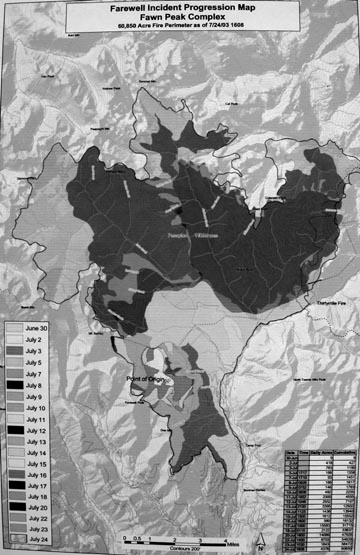
Map of the Farewell Fire from the US Forest Service - July 24, 2003 (CLICK to EXPAND)
Copyright © 2009 Pacific Biodiversity Institute
PO Box 298, 517 Lufkin Lane
Winthrop, WA 98862 509-996-2490
